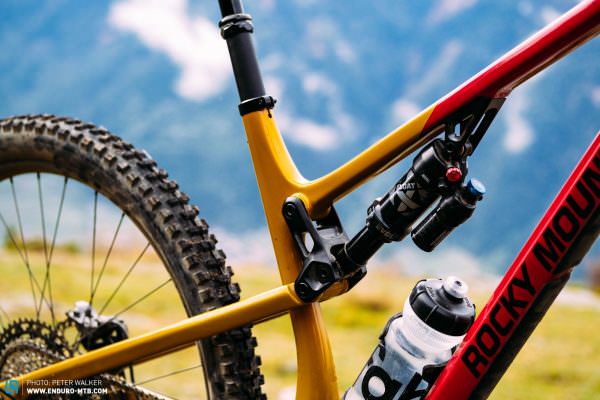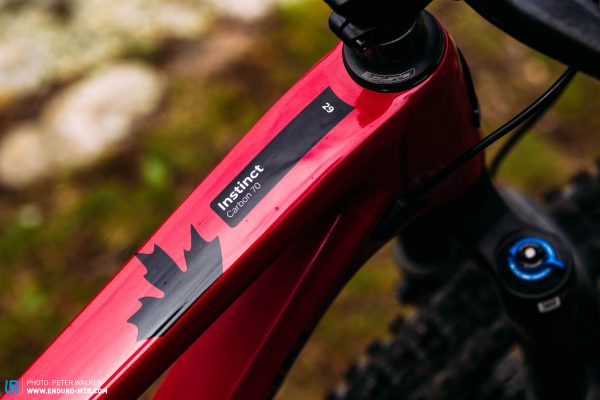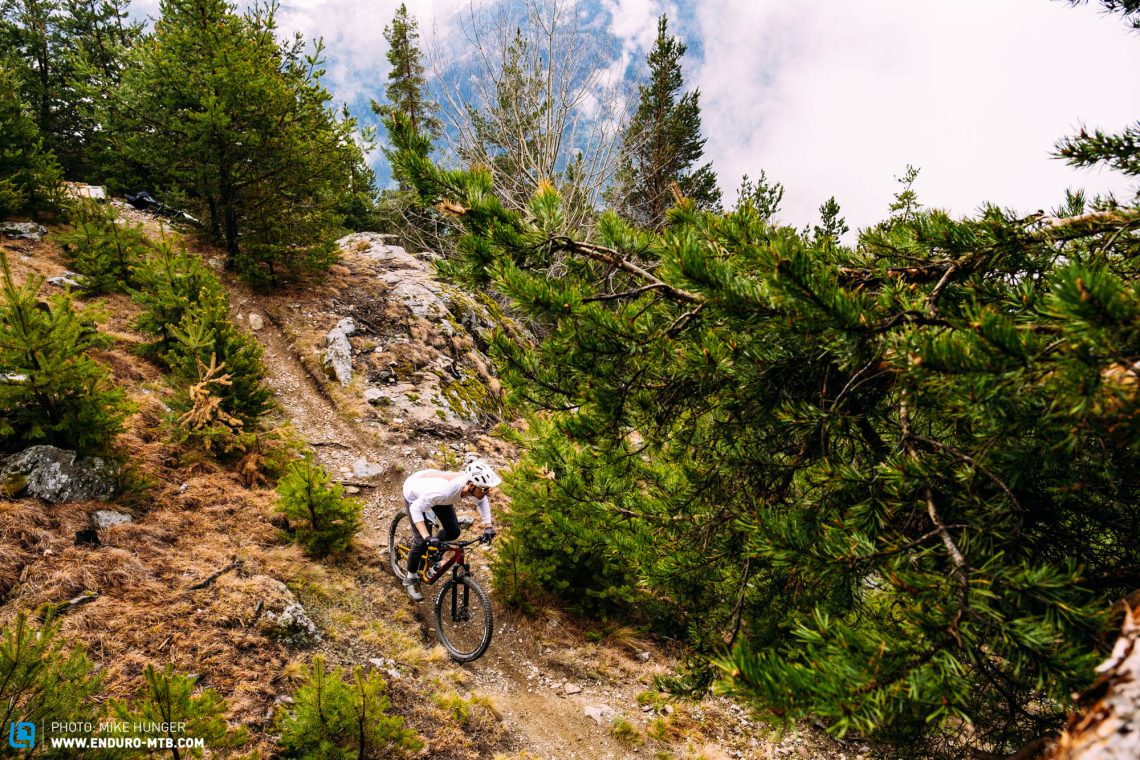With its flashy paint finish, the Rocky Mountain Instinct C70 is a real eye-catcher. It adopts the same frame platform as Rocky Mountain’s Altitude enduro bike and super variable RIDE-9 system, which should make it a great companion for rowdy trail sessions. But how did it stack up against the competition in our 2022 trail bike group test?
For an overview of the test fleet head to the group test: The best trail bike of 2022 – 14 models in review

Canadian manufacturer Rocky Mountain enter our 2022 trail bike group test with the € 7,199 Instinct C70. This combines 150/140 mm travel front and rear and employs the brand’s proprietary RIDE-9 system, which ensures super variable geometry. Since we deliberately asked Rocky Mountain not to send the flagship model into the race, our test bike comes equipped with more alloy parts than its high-end counterpart and therefore isn’t the lightest bike in this test at 14.3 kg in size L. Nevertheless, the spec still includes high-end components like the brakes and suspension and, besides that, more carbon parts don’t always translate into better trail performance.



The spec of the Rocky Mountain Instinct C70
With its flashy paint finish, the Rocky Mountain Instinct C70 immediately stands out from the crowd. It employs the same frame platform as Rocky Mountain’s enduro bike, the Altitude, but uses a different shock mount to reduce travel from 160 mm to 140 mm. Unfortunately, the mount isn’t available for purchase separately, otherwise you could rock two different builds with just one frame! A huge TPU plate protects the frame from impacts while a seat stay and chainstay protector prevents chainslap and paint chips. A small plastic fender above the main pivot point protects the rear end from flying debris and the cables are all securely clamped at the ports. Unfortunately, the frame of the Instinct doesn’t feature a tool mount or storage compartment, forcing you to carry around a backpack or hip pack with all your trail essentials or to stuff them in your riding pants.

With a total of 9 positions, the RIDE-9 system has huge tuning potential.

The 180 mm brake rotors at the front and rear are far too small, quickly overheating on steep descents and resulting in an inconsistent bite point and sub-par braking performance.

The FIT4 damper is light but lacks adjustment options and sensitivity on the trail.
Rocky Mountain Instinct C70
€ 7,199
Specifications
Fork FOX 36 FLOAT FIT4 150 mm
Rear Shock FOX FLOAT X Performance Elite 140 mm
Seatpost Race Face Turbine R 175 mm
Brakes Shimano XT 180/180 mm
Drivetrain Shimano XT 1x12
Stem Rocky Mountain 35 AM 40 mm
Handlebar Rocky Mountain AM Alu 780 mm
Wheelset Race Face AR 30 29"
Tires MAXXIS Minion DHF, 3C, MaxxTerra, EXO+/MAXXIS Minion DHR II, 3C, MaxxTerra, EXO+ 2.5/2.4
Technical Data
Size S M L XL
Weight 14.3 kg
Tuning Tip: upgrade both tires to something more robust with tougher casing and softer rubber compound at the front | bigger brake rotors

No other bike in this test has such a huge downtube protector.

The aluminium shock mount is the only difference between the Instinct and Altitude. Unfortunately, it’s not available for purchase separately.

A FOX 36 FIT4 FLOAT fork manages 150 mm travel at the front and is the same you get with the flagship Instinct model. Unfortunately, the FIT4 damper offers fewer adjustment options and less small-bump sensitivity than its superior GRIP2 counterpart. A FOX FLOAT X Performance Elite shock controls 140 mm travel at the rear and delivers the same excellent performance as its high-end Factory counterpart, albeit without the Kashima bling factor. For the 780 mm cockpit, Rocky Mountain rely on their in-house components. Shifting and braking is taken care of by a Shimano XT groupset, which ensures excellent performance on the trail. However, the small 180 mm brake rotors front and rear don’t do justice to the potential of the bike, so we recommend upgrading both rotors to a bigger 200 mm version.

A picture is worth a thousand words: even after a long day in the saddle, the Rocky Mountain is extremely comfortable.
Fellow Vancouverites Race Face supply the AR30 alloy wheelset and 175 mm Turbine R Dropper, which offers just enough travel for a trail bike in size L. MAXXIS take care of the rubber, combining a Minion DHF tire at the front and Minion DHR II at the rear, both with EXO+ casing and hard MaxxTerra rubber compound. In our opinion, the Instinct deserves more robust tires with a tougher casing, like MAXXIS’ DoubleDown, which offers better puncture protection and allows you to run lower air pressures. In addition, we’d recommend a softer and grippier rubber compound like MAXXIS’ MaxxGrip at the front.
Both the spec and frame details of the Rocky Mountain Instinct leave room for improvement.

The geometry of the Rocky Mountain Instinct C70
Using the RIDE-9 flip chip in the shock mount, you can fine-tune both the geometry and progression of the suspension of the Rocky Mountain Instinct C70 in… erm, you guessed it, 9 stages. In the slackest setting, the Instinct has a 65.1° head angle, while in the highest, this steepens by just over one degree to 66.2°. As if that wasn’t already enough, Rocky Mountain let you set the chainstay length between 438 and 448 mm simply by changing the position of the flip chip in the dropouts and flipping the proprietary two-position brake mount, without the need of additional parts. We rode the bike almost exclusively in the slacker and more progressive 1 setting and longest chainstay position. The Instinct combines 481 mm reach and a 445 mm seat tube, which is sufficiently short, ensuring good freedom of movement on descents.
The geometry of the Rocky Mountain Instinct C70 in position 1 and longest chainstay position
| size | S | M | L | XL |
|---|---|---|---|---|
| Seat tube | 380 mm | 420 mm | 445 mm | 480 mm |
| Top tube | 583 mm | 609 mm | 638 mm | 671 mm |
| Head tube | 90 mm | 95 mm | 110 mm | 125 mm |
| Head angle | 65° | 65,1° | 65,1° | 65,1° |
| Seat angle | 76,0° | 77,1° | 77,1° | 77,1° |
| Chainstays | 449 mm | 449 mm | 449 mm | 449 mm |
| BB Drop | 45 mm | 43 mm | 43 mm | 43 mm |
| Wheelbase | 1.182 mm | 1.210 mm | 1.241 mm | 1.277 mm |
| Reach | 430 mm | 456 mm | 481 mm | 511 mm |
| Stack | 615 mm | 619 mm | 633 mm | 646 mm |

The Rocky Mountain Instinct C70 on the trail
The pedalling position is comfortably centred and doesn’t put too much pressure on your hands, making the Rocky Mountain Instinct C70 suitable for epic backcountry adventures. However, the rear end bobs slightly when pedalling, calling for the climb switch on very long climbs. Even on steep uphills, the front wheel always remains planted on the trail while the rear suspension generates good traction even in technical climbing sections, provided the shock is in Open mode.



The rear suspension of the Instinct works very efficiently and generates plenty of traction, encouraging you to push the envelope: test rider Simon did just that, waiting until the last second to slam the brakes.
Riding downhill, the Instinct is intuitive to ride and impresses with stoic composure. However, in open corners you’ll have to actively weight the front wheel to compensate for the hard rubber compound and the fork’s lack of small bump sensitivity. The Instinct implements steering inputs willingly, making it easy to thread your way through tight corners on narrow forest trails. At the same time, it’s good-natured and predictable enough to forgive the odd riding mistake, kindly bailing you out if you get yourself into a pickle. The suspension works efficiently and offers plenty of reserves for botched landings and huck-to-flats. All in all, it’s designed for traction rather than support. Active riders who like to improvise with their lines and keep the fingers off the brakes until the very last second will have a ball onboard the Instinct.
The super variable suspension generates plenty of traction and makes the Rocky Mountain Instinct a versatile all-rounder.

Conclusion
With Rocky Mountain’s proprietary RIDE-9 system, the Instinct C70 has a super variable geometry. Unfortunately, the spec still leaves room for improvement, especially when it comes to the brake rotors, tires and fork. The frame details aren’t entirely up to date either. And yet, the Instinct convinces with excellent all-round qualities, which make it perfectly suitable for touring. Overall, it’s a potent trail bike that impresses with playful, agile handling and generates tons of traction with its efficient suspension.
Tops
- versatile variable geometry
- efficient suspension generates tons of traction
- excellent all-round qualities
Flops
- spec leaves room for improvement
- neither a tool mount nor a storage compartment
You can find out more about at intl.bikes.com

The test field
For an overview of the test fleet head to the group test: The best trail bike of 2022 – 14 models in review
All bikes in test: Atherton AM.150 (Click for review) | Bold Linkin 135 Ultimate (Click for review) | Canyon Spectral 125 CF 9 (Click for review) | Canyon Spectral CFR (Click for review) | FOCUS JAM 8.9 (Click for review) | Mondraker Raze RR SL (Click for review) | Propain Hugene (Click for review) | Rocky Mountain Instinct C70 (Click for review) | ROSE BONERO 3 (Click for review) | Santa Cruz Bronson CC X01 AXS (Click for review) | SCOR 4060 ST GX (Click for review) | Specialized Stumpjumper EVO S-Works (Click for review) | Specialized Stumpjumper EVO Elite Alloy (Click for review) | YT JEFFSY UNCAGED 6 (Click for review)

Did you enjoy this article? If so, we would be stoked if you decide to support us with a monthly contribution. By becoming a supporter of ENDURO, you will help secure a sustainable future for high-quality mountain bike journalism. Click here to learn more.
Words: Simon Kohler Photos: Peter Walker, Mike Hunger









